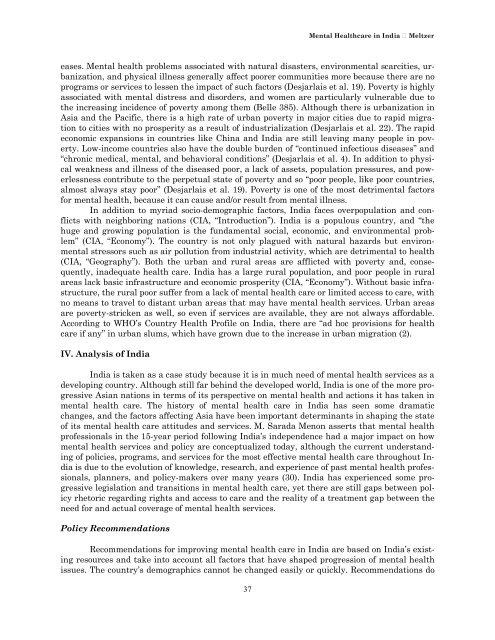Pepperdine University School of Public Policy
Pepperdine University School of Public Policy
Pepperdine University School of Public Policy
Create successful ePaper yourself
Turn your PDF publications into a flip-book with our unique Google optimized e-Paper software.
Mental Healthcare in India Meltzer<br />
eases. Mental health problems associated with natural disasters, environmental scarcities, urbanization,<br />
and physical illness generally affect poorer communities more because there are no<br />
programs or services to lessen the impact <strong>of</strong> such factors (Desjarlais et al. 19). Poverty is highly<br />
associated with mental distress and disorders, and women are particularly vulnerable due to<br />
the increasing incidence <strong>of</strong> poverty among them (Belle 385). Although there is urbanization in<br />
Asia and the Pacific, there is a high rate <strong>of</strong> urban poverty in major cities due to rapid migration<br />
to cities with no prosperity as a result <strong>of</strong> industrialization (Desjarlais et al. 22). The rapid<br />
economic expansions in countries like China and India are still leaving many people in poverty.<br />
Low-income countries also have the double burden <strong>of</strong> “continued infectious diseases” and<br />
“chronic medical, mental, and behavioral conditions” (Desjarlais et al. 4). In addition to physical<br />
weakness and illness <strong>of</strong> the diseased poor, a lack <strong>of</strong> assets, population pressures, and powerlessness<br />
contribute to the perpetual state <strong>of</strong> poverty and so “poor people, like poor countries,<br />
almost always stay poor” (Desjarlais et al. 19). Poverty is one <strong>of</strong> the most detrimental factors<br />
for mental health, because it can cause and/or result from mental illness.<br />
In addition to myriad socio-demographic factors, India faces overpopulation and conflicts<br />
with neighboring nations (CIA, “Introduction”). India is a populous country, and “the<br />
huge and growing population is the fundamental social, economic, and environmental problem”<br />
(CIA, “Economy”). The country is not only plagued with natural hazards but environmental<br />
stressors such as air pollution from industrial activity, which are detrimental to health<br />
(CIA, “Geography”). Both the urban and rural areas are afflicted with poverty and, consequently,<br />
inadequate health care. India has a large rural population, and poor people in rural<br />
areas lack basic infrastructure and economic prosperity (CIA, “Economy”). Without basic infrastructure,<br />
the rural poor suffer from a lack <strong>of</strong> mental health care or limited access to care, with<br />
no means to travel to distant urban areas that may have mental health services. Urban areas<br />
are poverty-stricken as well, so even if services are available, they are not always affordable.<br />
According to WHO’s Country Health Pr<strong>of</strong>ile on India, there are “ad hoc provisions for health<br />
care if any” in urban slums, which have grown due to the increase in urban migration (2).<br />
IV. Analysis <strong>of</strong> India<br />
India is taken as a case study because it is in much need <strong>of</strong> mental health services as a<br />
developing country. Although still far behind the developed world, India is one <strong>of</strong> the more progressive<br />
Asian nations in terms <strong>of</strong> its perspective on mental health and actions it has taken in<br />
mental health care. The history <strong>of</strong> mental health care in India has seen some dramatic<br />
changes, and the factors affecting Asia have been important determinants in shaping the state<br />
<strong>of</strong> its mental health care attitudes and services. M. Sarada Menon asserts that mental health<br />
pr<strong>of</strong>essionals in the 15-year period following India’s independence had a major impact on how<br />
mental health services and policy are conceptualized today, although the current understanding<br />
<strong>of</strong> policies, programs, and services for the most effective mental health care throughout India<br />
is due to the evolution <strong>of</strong> knowledge, research, and experience <strong>of</strong> past mental health pr<strong>of</strong>essionals,<br />
planners, and policy-makers over many years (30). India has experienced some progressive<br />
legislation and transitions in mental health care, yet there are still gaps between policy<br />
rhetoric regarding rights and access to care and the reality <strong>of</strong> a treatment gap between the<br />
need for and actual coverage <strong>of</strong> mental health services.<br />
<strong>Policy</strong> Recommendations<br />
Recommendations for improving mental health care in India are based on India’s existing<br />
resources and take into account all factors that have shaped progression <strong>of</strong> mental health<br />
issues. The country’s demographics cannot be changed easily or quickly. Recommendations do<br />
37












